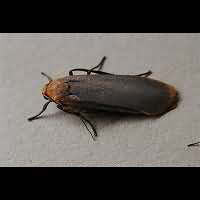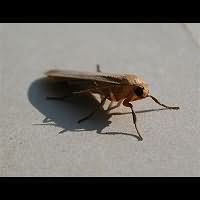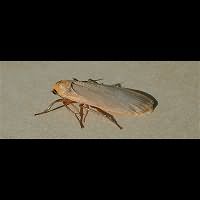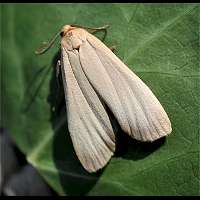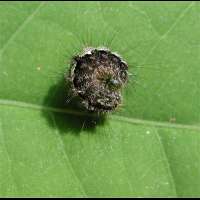Buff Footman (Eilema depressa)
Male and female of the Buff Footman differ considerably. The male is not only smaller than the female, it is also lighter in colour and far less contrastingly marked. He has buff wings, often with just a hint of a small orange line among the upper edge of the forwing. His fringes at the tops of the wings may also be slightly orange, but not necessarily so. He's not very difficult to identify. The female is bigger. Her wings are grey or even lead grey and have a clear orange line running on the outer edge of the frontwing. The tips of the wings usually have orange colourings as well. She does look like many of the other greyish footman, especially the Dingy Footman. Still, this species normally only has the head orange, the rest of the body is grey. The female Buff Footman often has the orange colour on all body parts visible between the wings. The Buff Footman never rolls it's wings around it's body, but always keeps them out, or puts one wing completely over the other. The males have a wingspan of 28 to 32 mm, the females have a wingspan of 32 to 36 mm.
The eggs are being laid in summer, but don't hatch before september. The young caterpillars of the Buff Footman do eat, but not a lot and they don't grow very fast during this stage. The still very small larvae overwinter sitting on bark or in lyches, not taking any apparent precautions against winter. In spring they become active again, start eating again and now grow rapidly. From May they'll pupate. They'll spin a cocoon, usually in a crevice of bark, where pupation takes 4 to 8 weeks. The caterpillars themselves are not very big and easily identified: look for a hairy, brownish black ceterpillar with a big, whitish dorsal line, interrupted three times by a black marking: on segments 3, 7 and 11. It will reach a length of 20 to 24 mm only and feeds on mosses and lyches growing on various trees, such as oak, yew, hawthorn and firs.
The Buff Footman is single brooded and is on the wing in June and July mainly. Flies by night exclusively, but both female and male are attracted to light. Easily disturbed during the day and unrestful for a long time after it is caught. Once settled down, may be photographed without much ado. This is a local species only scattered throughout southern parts of England, Wales and Ireland. It is a local species on the continent as well. But where it lives, it usually isn't rare at all.
NB This species is scientifically also known as Eilema deplana.
Male and female of the Buff Footman differ considerably. The male is not only smaller than the female, it is also lighter in colour and far less contrastingly marked. He has buff wings, often with just a hint of a small orange line among the upper edge of the forwing. His fringes at the tops of the wings may also be slightly orange, but not necessarily so. He's not very difficult to identify. The female is bigger. Her wings are grey or even lead grey and have a clear orange line running on the outer edge of the frontwing. The tips of the wings usually have orange colourings as well. She does look like many of the other greyish footman, especially the Dingy Footman. Still, this species normally only has the head orange, the rest of the body is grey. The female Buff Footman often has the orange colour on all body parts visible between the wings. The Buff Footman never rolls it's wings around it's body, but always keeps them out, or puts one wing completely over the other. The males have a wingspan of 28 to 32 mm, the females have a wingspan of 32 to 36 mm.
The eggs are being laid in summer, but don't hatch before september. The young caterpillars of the Buff Footman do eat, but not a lot and they don't grow very fast during this stage. The still very small larvae overwinter sitting on bark or in lyches, not taking any apparent precautions against winter. In spring they become active again, start eating again and now grow rapidly. From May they'll pupate. They'll spin a cocoon, usually in a crevice of bark, where pupation takes 4 to 8 weeks. The caterpillars themselves are not very big and easily identified: look for a hairy, brownish black ceterpillar with a big, whitish dorsal line, interrupted three times by a black marking: on segments 3, 7 and 11. It will reach a length of 20 to 24 mm only and feeds on mosses and lyches growing on various trees, such as oak, yew, hawthorn and firs.
The Buff Footman is single brooded and is on the wing in June and July mainly. Flies by night exclusively, but both female and male are attracted to light. Easily disturbed during the day and unrestful for a long time after it is caught. Once settled down, may be photographed without much ado. This is a local species only scattered throughout southern parts of England, Wales and Ireland. It is a local species on the continent as well. But where it lives, it usually isn't rare at all.
NB This species is scientifically also known as Eilema deplana.

